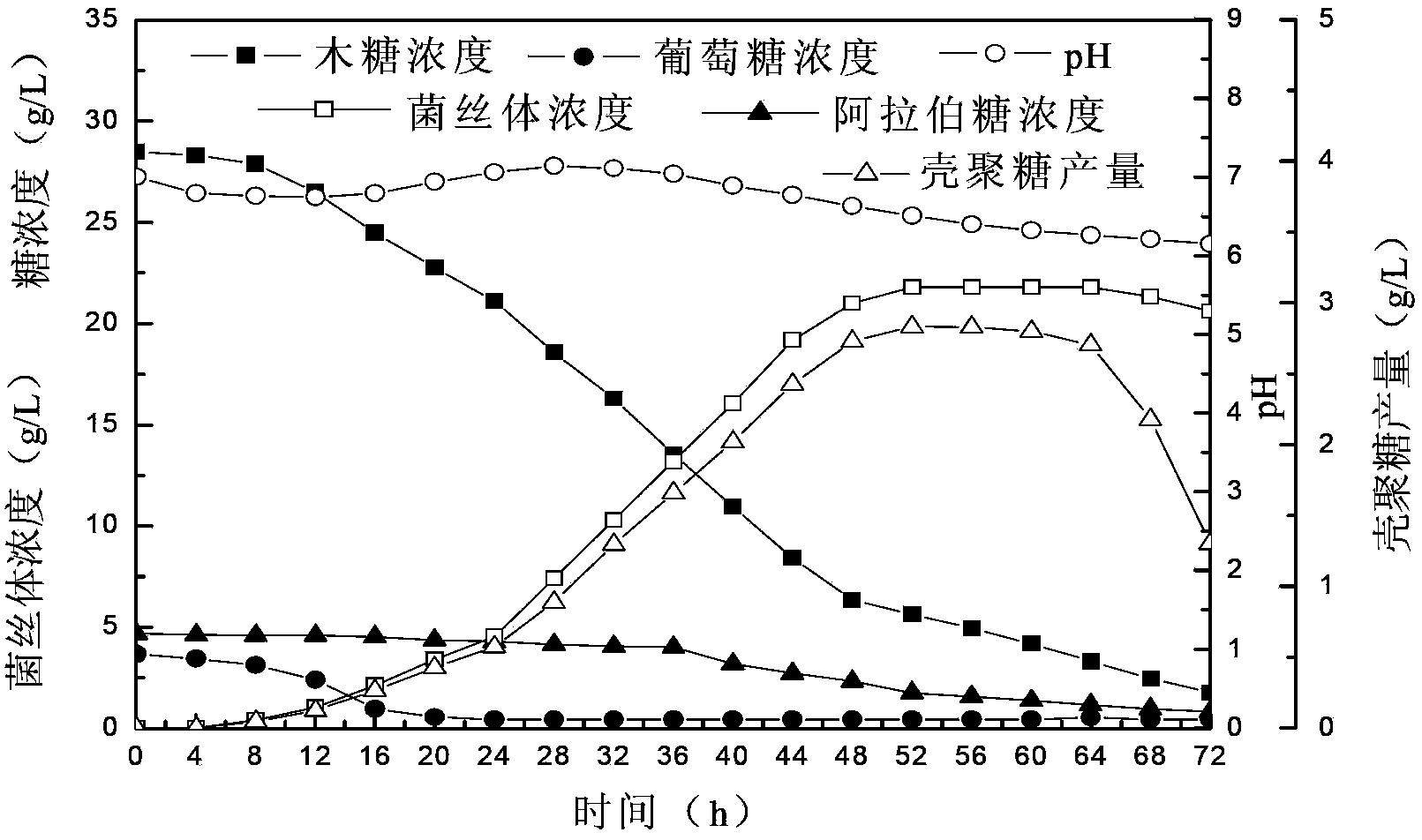Method for preparing chitosan by xylose in hemicellulose hydrolysate
A technology of hemicellulose and hydrolyzate, applied in microorganism-based methods, biochemical equipment and methods, microorganisms, etc., can solve the problems of undiscovered patent publications, etc., and achieve the effects of simple method, reduced environmental pollution, and convenient operation.
- Summary
- Abstract
- Description
- Claims
- Application Information
AI Technical Summary
Problems solved by technology
Method used
Image
Examples
Embodiment 1
[0033] A method utilizing xylose in hemicellulose hydrolyzate to prepare chitosan, the steps are as follows:
[0034] ⑴Hydrolysis of hemicellulose raw materials: After the corn cob is crushed, it is sieved so that the particle size does not exceed 1mm; the crushed corn cob is mixed with H 2 SO 4 Solution by cob: H 2 SO 4 The solid-to-liquid ratio g:mL of the solution is 1:10, and hydrolyzed in a hydrolysis pot at 120°C for 2 hours to obtain a hemicellulose hydrolyzate;
[0035] (2) Detoxification and decolorization treatment: add Ca(OH) to the hemicellulose hydrolyzate obtained in step (1) 2 Adjust the pH to 10, and obtain a supernatant after solid-liquid separation, and use 10% H in the supernatant 2 SO 4 The pH of the solution is adjusted to 7, and the solid-liquid separation obtains the supernatant; 2 Add activated carbon to the detoxified supernatant at a solid-to-liquid ratio of 1:20 (g:mL), incubate at 50°C for 1 hour, and filter to obtain the detoxified and decolo...
Embodiment 2
[0048] A method utilizing xylose in hemicellulose hydrolyzate to prepare chitosan, the steps are as follows:
[0049] ⑴Hydrolysis of hemicellulose raw materials: After the corn cob is crushed, it is sieved so that the particle size does not exceed 1mm; the crushed corn cob is mixed with H 2 SO 4 Solution by cob: H 2 SO 4 The solid-to-liquid ratio g:mL of the solution is 1:10, and hydrolyzed in a hydrolysis pot at 100°C for 2 hours to obtain a hemicellulose hydrolyzate;
[0050] (2) Detoxification and decolorization treatment: add Ca(OH) to the hemicellulose hydrolyzate obtained in step (1) 2 Adjust the pH to 9, obtain the supernatant after solid-liquid separation, and use 10% H in the supernatant 3 PO 4 The pH of the solution is adjusted to 6, and the solid-liquid separation obtains the supernatant; 2 Add activated carbon to the supernatant after detoxification treatment at a solid-to-liquid ratio of 1:50 (g:mL), incubate at 50°C for 0.5h, filter to obtain hemicellulose ...
Embodiment 3
[0062] A method utilizing xylose in hemicellulose hydrolyzate to prepare chitosan, the steps are as follows:
[0063] ⑴Hydrolysis of hemicellulose raw materials: After the corn cob is crushed, it is sieved so that the particle size does not exceed 1mm; the crushed corn cob is mixed with H 2 SO 4 Solution by cob: H 2 SO 4 The solid-to-liquid ratio g:mL of the solution is 1:10, and hydrolyzed in a hydrolysis pot at 120°C for 3 hours to obtain a hemicellulose hydrolyzate;
[0064] (2) Detoxification and decolorization treatment: add Ca(OH) to the hemicellulose hydrolyzate obtained in step (1) 2 Adjust the pH to 11, obtain the supernatant after solid-liquid separation, and use 10% H in the supernatant 2 SO 4 The pH of the solution is adjusted to 8, and the solid-liquid separation obtains the supernatant; 2 Add activated carbon to the supernatant after detoxification treatment at a solid-to-liquid ratio of 1:25 (g:mL), incubate at 50°C for 2 hours, and filter to obtain hemice...
PUM
 Login to View More
Login to View More Abstract
Description
Claims
Application Information
 Login to View More
Login to View More - R&D
- Intellectual Property
- Life Sciences
- Materials
- Tech Scout
- Unparalleled Data Quality
- Higher Quality Content
- 60% Fewer Hallucinations
Browse by: Latest US Patents, China's latest patents, Technical Efficacy Thesaurus, Application Domain, Technology Topic, Popular Technical Reports.
© 2025 PatSnap. All rights reserved.Legal|Privacy policy|Modern Slavery Act Transparency Statement|Sitemap|About US| Contact US: help@patsnap.com

